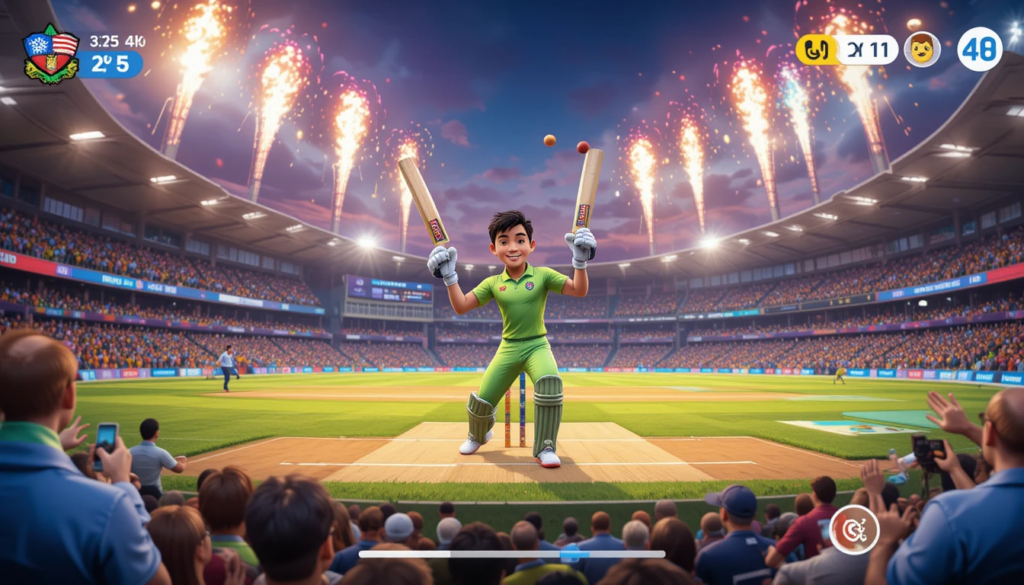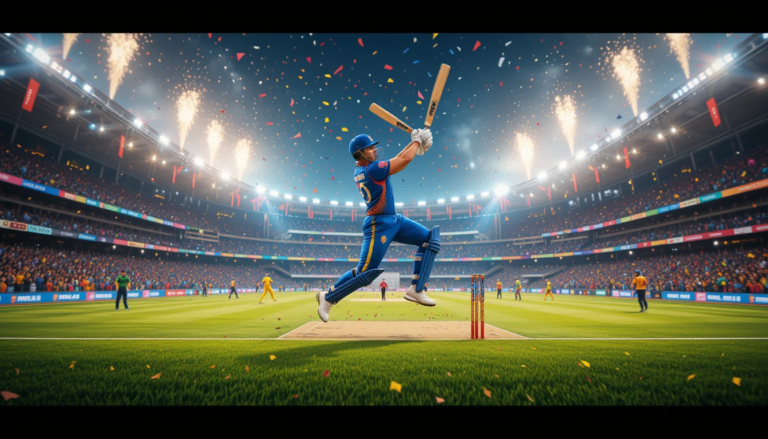Inside the Game: How Developers Build Realistic Cricket Simulators – 2025 Edition
Introduction
Cricket simulators have come a long way from pixelated players and rigid controls to hyper-realistic stadiums, dynamic physics, and AI that mimics real-world strategies. As mobile devices, PCs, and consoles continue to grow more powerful, the demand for lifelike cricket simulators has never been higher.
But what goes into crafting these virtual experiences that millions of fans enjoy? How do developers blend art, science, and cricketing knowledge to bring this beloved sport to the digital world? In this article, we’ll take a deep dive into how developers build realistic cricket simulators in 2025—from the technology and research involved to gameplay balancing, AI modeling, and immersive visuals.

1. Research and Conceptualization
Before a single line of code is written, the journey begins with extensive research.
Understanding the Sport
Developers study every aspect of cricket:
- Field dimensions and stadium architecture
- Rules and variations (ODI, Test, T20, etc.)
- Player roles and behavior
- Physics of ball movement and spin
Many studios consult with professional cricketers and coaches to ensure authenticity. Former players help game designers recreate gameplay moments and strategies that only real athletes understand.
Creating a Vision Document
A vision document outlines:
- Game type: Arcade vs. Simulation
- Target platform: Mobile, Console, or PC
- Core experience: Career mode, online multiplayer, real tournaments
- Style: Realistic, stylized, or hybrid
2. Physics Engine and Ball Mechanics

One of the most complex parts of cricket games is ball physics.
Realistic Ball Behavior
To simulate a cricket ball’s movement:
- Speed and angle calculations replicate swing, seam, and spin.
- Surface friction on the pitch changes ball trajectory.
- Environmental factors like wind and humidity are coded into the engine.
Modern games use real-world physics engines like Unity or Unreal Engine to simulate how the ball bounces, deviates, or edges based on timing and bat angle.
Bat-Ball Interaction
Timing plays a critical role:
- Early or late shots change direction.
- Power depends on backswing and player skill.
- Edge detection is now calculated using micro-collision zones on the bat.
3. Motion Capture and Animation
To achieve lifelike player movements, developers rely heavily on motion capture technology.
Real Cricketers in the Studio
Professional players perform:
- Bowling actions (fast, spin, swing)
- Batting shots (drives, pulls, cuts, lofts)
- Fielding moves (dives, throws, catches)
These actions are captured with motion sensors and translated into 3D animations. Animators clean up the data for fluidity and responsiveness.
Facial Animations

In 2025, facial motion capture is widely used:
- Players express joy, frustration, or focus.
- Reactions vary based on match scenarios (e.g., dropping a catch).
- Celebrations after wickets or milestones are customized.
4. AI and Strategy Simulation
Smart Opponents and Teammates
AI in modern cricket simulators learns and adapts:
- Bowlers identify your weak zones.
- Fielders adjust based on batting patterns.
- Captains rotate bowlers and set dynamic field placements.
The AI engine uses predictive modeling and machine learning to replicate real-world decision-making.
Difficulty Levels
To ensure fair gameplay:
- Lower levels offer more predictable patterns.
- Higher difficulties feature smarter bowlers, deceptive deliveries, and aggressive chases.
- Some games even simulate momentum shifts like in real cricket.
5. Sound Design and Commentary
Sound is critical to immersion.
Authentic Stadium Ambience
Developers record real crowd noises from international matches. Cheers, gasps, national anthems, and stadium horns are layered to match gameplay intensity.
Commentary System

Modern cricket simulators feature dynamic commentary engines:
- Multiple languages and accents
- Commentary varies based on player performance
- Real-time reactions to sixes, milestones, or collapses
The 2025 generation also supports AI-generated commentary, adapting to gameplay like a live commentator would.
6. Stadium and Environment Design
Real Stadium Modeling
Developers use drone photography, 3D scanning, and blueprints to recreate famous stadiums:
- Lord’s, Eden Gardens, MCG, etc.
- Accurate pitch texture, lighting rigs, sponsor boards, and crowd capacity
Environmental Effects
Simulators now feature:
- Day-night transitions
- Dynamic weather (clouds, fog, drizzle)
- Shadow shifts based on sun angle
Some games even simulate pitch wear and tear during Test matches.
7. Player Modeling and Licensing
Accurate Player Avatars
Developers use face scanning and 3D modeling to replicate:
- Realistic facial features
- Player height, build, posture
- Custom animations for iconic cricketers (e.g., Dhoni’s helicopter shot)
Official Licensing
To use real names, likenesses, and kits:
- Developers acquire licenses from cricket boards (BCCI, ECB, ICC, etc.)
- Unlicensed games use fictional names unless modding is supported.
In 2025, more games are turning to NFT-based licensing, giving players ownership of digital cricket cards and characters.
8. Game Modes and Career Simulation

Popular Game Modes
- Quick Match
- Tournaments (World Cup, IPL, etc.)
- Career Mode (Single-player progression)
- Online Multiplayer
- Challenge Mode (Historic moments or daily missions)
Career Mode in Depth
A player creates their avatar and climbs the ladder:
- Start in domestic leagues
- Get selected for national duty
- Train to improve attributes
- Handle media and endorsement events
In some simulators, off-field decisions impact on-field performance (e.g., training, rest, diet).
9. UI/UX and Player Controls
On Mobile Devices
- Touch controls optimized for quick swipes and taps
- Haptic feedback during key moments
- Simplified HUD with real-time updates
On Consoles and PC
- Precision input through analog sticks
- Keyboard shortcuts for field setup and power plays
- Split-screen and online multiplayer support
UI is kept minimalistic to not obstruct the visuals while being responsive to in-game actions.
10. Testing and Player Feedback
Extensive QA Testing
Before launch, cricket simulators undergo:
- Motion tests for ball trajectory
- Timing checks for shot accuracy
- Edge cases like glitches or physics breaks
- Multiplayer stress testing
Community Beta Programs
Studios like Nextwave and Nautilus run beta tests with real players to:
- Balance gameplay mechanics
- Identify bugs and inconsistencies
- Get feedback on UI, camera angles, and AI difficulty
11. Post-Launch Support
Regular Updates
Post-release, developers release:
- Patch fixes
- Player roster updates
- New stadiums or tournaments
- Festive events or promotional skins
Modding and User Content
Some games allow the community to create:
- Custom leagues
- Stadium skins
- Commentary packs
- Player kits
In 2025, Real Cricket 25 and WCC Rivals introduced official modding tools, encouraging fan creativity.
12. Esports Integration
Esports is a growing part of cricket simulators.
Features Supporting Competitive Play
- Anti-cheat mechanisms
- Ranked modes and divisions
- Tournament brackets and scoreboards
- Integrated spectator cameras
Real-World Tournaments
- Cricket Esports Premier League
- ICC Virtual Trophy
- Country vs. Country Digital Clashes
In 2025, some broadcasters even stream these matches alongside real cricket games.
Conclusion
Behind the seamless gameplay and stunning visuals of modern cricket simulators lies a world of deep planning, precision engineering, and passionate development. From physics calculations and AI scripting to motion-captured animations and career modes, creating a realistic cricket experience is a complex, collaborative journey.
As we move further into the future, with technologies like VR, AR, and AI continuing to evolve, cricket simulators will only become more immersive and intelligent. What we’re seeing in 2025 is just the beginning—a new innings in the legacy of digital cricket.
Whether you’re a gamer, a cricket fan, or both, it’s fascinating to see how these digital stadiums are built — brick by virtual brick.




